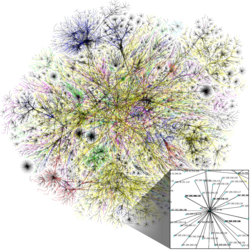This article may be too technical for most readers to understand.(January 2018) |
| Internet |
|---|
 |
| |
An information infrastructure is defined by Ole Hanseth (2002) as "a shared, evolving, open, standardized, and heterogeneous installed base" [1] and by Pironti (2006) as all of the people, processes, procedures, tools, facilities, and technology which support the creation, use, transport, storage, and destruction of information. [2]
Contents
- Definitions
- Theories
- Dimensions
- As a public policy
- Global Information Infrastructure (GII)
- Regional information infrastructure
- Asia
- North America
- Europe
- Africa
- See also
- Notes
- References
- External links
The notion of information infrastructures, introduced in the 1990s and refined during the following decade, has proven quite fruitful to the information systems (IS) field. It changed the perspective from organizations to networks and from systems to infrastructure, allowing for a global and emergent perspective on information systems. Information infrastructure is a technical structure of an organizational form, an analytical perspective or a semantic network.
The concept of information infrastructure (II) was introduced in the early 1990s, first as a political initiative (Gore, 1993 & Bangemann, 1994), later as a more specific concept in IS research. For the IS research community, an important inspiration was Hughes' (1983) accounts of large technical systems, analyzed as socio-technical power structures (Bygstad, 2008). [3] Information infrastructure are typically different from the previous generations of "large technological system" because these digital sociotechnical systems are considered generative, meaning they allow new users to connect with or even appropriate the system. [4]
Information infrastructure, as a theory, has been used to frame a number of extensive case studies (Star and Ruhleder 1996; Ciborra 2000; Hanseth and Ciborra 2007), and in particular to develop an alternative approach to IS design: "Infrastructures should rather be built by establishing working local solutions supporting local practices which subsequently are linked together rather than by defining universal standards and subsequently implementing them" (Ciborra and Hanseth 1998). It has later been developed into a full design theory, focusing on the growth of an installed base (Hanseth and Lyytinen 2008).
Information infrastructures include the Internet, health systems and corporate systems. [5] It is also consistent to include innovations such as Facebook, LinkedIn and MySpace as excellent examples (Bygstad, 2008). Bowker has described several key terms and concepts that are enormously helpful for analyzing information infrastructure: imbrication, bootstrapping, figure/ground, and a short discussion of infrastructural inversion. "Imbrication" is an analytic concept that helps to ask questions about historical data. "Bootstrapping" is the idea that infrastructure must already exist in order to exist (2011).